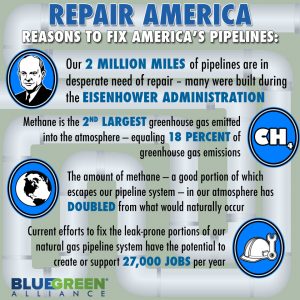Reasons to Fix America’s Natural Gas Distribution Pipelines
America has 2 million miles of pipeline — much of which was built during the Eisenhower administration. No wonder they're in desperate need for repair.
 Along with calls for the development of additional renewable energy sources, smarter energy use by maximizing energy conservation practices and, and limits on carbon emissions from power plants, President Obama’s climate change plan set a goal of further reducing America’s methane emissions.
Along with calls for the development of additional renewable energy sources, smarter energy use by maximizing energy conservation practices and, and limits on carbon emissions from power plants, President Obama’s climate change plan set a goal of further reducing America’s methane emissions.
Methane is the second-largest greenhouse gas emitted into the atmosphere, contributing 18 percent of our emissions. It is a gas that has been building up in our atmosphere, and the amount of methane in our atmosphere is now double what would normally occur. Methane is on average 37 times more potent than carbon dioxide and stays in the atmosphere for an average of about 12 years — longer than other greenhouse gases.
Much of our methane emissions come from leaks in our nation’s more than 2 million miles of gas pipelines. Many of these pipelines were built the Eisenhower Administration and are in desperate need of repair.
This year, the American Society of Civil Engineers issued America’s energy systems a D+ grade in their quadrennial infrastructure report card. Our natural gas pipeline networks in particular are subject to the impacts of age and the elements, prone to material degradation and becoming technologically outdated. As we transition to a clean energy economy, we must ensure our municipal natural gas distribution systems are made safer and more efficient in order to improve community and worker health and safety, a cleaner environment and to reduce their overall climate change impact.
Not only will doing so help us significantly cut our greenhouse gas emissions and protect our communities, current efforts to fix the leak-prone portions of our natural gas distribution system have the potential to create or support 27,000 jobs per year.
Fixing our nation’s pipelines is truly a win-win-win.